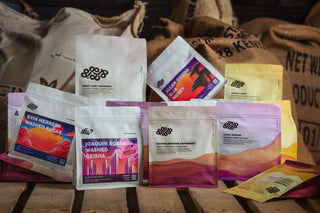In order to make every drink we serve as good as it can possibly be we have changed the way we pull shots for milk drinks and Americanos at Phil & Sebastian. We now pull smaller and shorter espresso shots for all of our milk based drinks and Americanos. Our new target parameter for these shots is a 25g output +/‐3g.
Some History
This year marks our 6th year competing in barista competitions. Each year we devote some time to trying different ways to improve our cappuccinos. One thing that we always settled on was cutting the shots slightly shorter for the cappuccino course than for the espresso course. We found that there was still a nice amount of coffee presence and origin and that there was less perceived bitterness. We used this style of shots at competitions, but never launched them in our cafe because of the difficulty of launching a new method across 4 locations.
I believe that one of the overlooked benefits of competition is using the competition arena to field test quality initiatives and then apply them to the cafe. After years of knowing how to pull better shots for drinks that are not straight espresso, we were determined to apply this knowledge to our cafes. We spent time in the cafes testing different ways to systematize this new method and make it consistent. The result is this article.

Why?
We want all the drinks that we serve to be balanced. There are many ways to describe balance in food and drink, but I think that in coffee there are two factors that contribute quite heavily to balance: Acidity and bitterness. If a drink has a pleasant acidity and an almost imperceptible amount of bitterness it is highly likely that the drink is going to be balanced. Each drink on a menu presents a different ratio of acidity/bitterness and it is up to us as baristas to balance these elements. To create a balanced drink you have to consider what drink you are making and what your ingredients are.
Espresso can be a very intense and acidic drink if it is not properly brewed. In order to create a balanced espresso, baristas will often adjust how much blonde they add to the end of the shot. The blonde is low in acid and does not contain much coffee solubles so it does a very good job balancing the espresso. Generally, the espresso parameters used to dial in are designed to create this style of espresso: straight espresso for drinking.
Lattes and cappuccinos present a different acidity/bitterness ratio because they contain a third ingredient: milk. Because the milk is sweet and is not acidic it does a very good job softening the intensity and acidity of the espresso. Now a smaller, less extracted, more intense shot is a good thing. The lower amount of extraction will ensure that there is not any perceivable bitterness in the latte and the lower amount of total water in the espresso means that the milk isn’t getting too watered down, which maximizes the sweetness of the drink.
A secondary benefit to this new way of pulling shots for milk drinks it that it is much more efficient in a cafe setting because the shot time for milk drinks is approximately 10 seconds shorter than the shot time for espresso (based on our recommended espresso brewing parameters).
Every drink at Phil & Sebastian uses the new style of shots—except for espresso.
How?
Regardless of what machine you are working on, the way you dial and taste the straight espresso remains the same. The only thing that is changing when you pull a shot for a milk drink or Americano is your shot time and the output. The shot time will be shorter in order to achieve the 25g target output. Dose and grind are the same for both types of shot.
In the cafes, we always dial to the straight espresso and never adjust the time on the smaller shots. The espresso shots for milk drinks and Americanos should be based off the straight espressos flow rate.





Why spend so much time dialing the espresso just to pull the coffee differently the whole day?
By dialing in the espresso for straight espresso you are also dialing in the milk drinks and Americanos. To properly pull a shot for a milk drink the flow rate cannot be too slow or too fast. If it is too slow the water will have more than sufficient contact time with the coffee to fully extract the coffee, resulting in bitterness in the milk drink (this is because the milk highlights the bitterness in espresso that is normally imperceivable as a straight shot). If the shot is too fast the espresso will be too underextracted and it won’t have enough brew strength, making the drinks taste watered down and lacking origin. Dialing the espresso and then adjusting the cutoff point based on the dialed settings ensures that the coffee isn’t overextracted or too underextracted.
What about single shots?
For single shot drinks we pull a straight espresso style shot and split it in half. The reason to use the bigger, straight espresso shot is because it is difficult to quickly weight out 12.5g of espresso without a large margin of error. For example, if you weight out 10g of espresso instead of 12.5g you are adding 20% less espresso to the drink.







